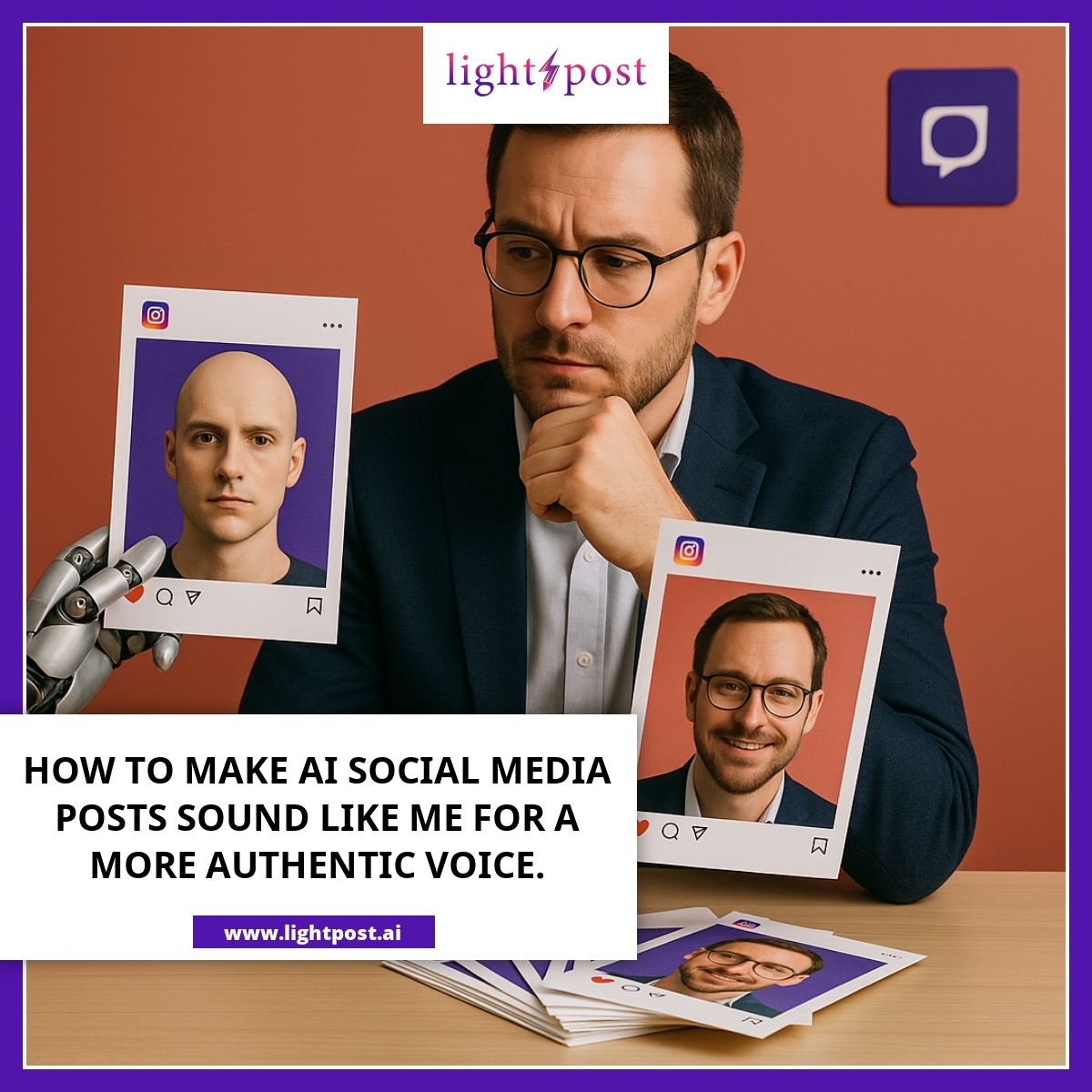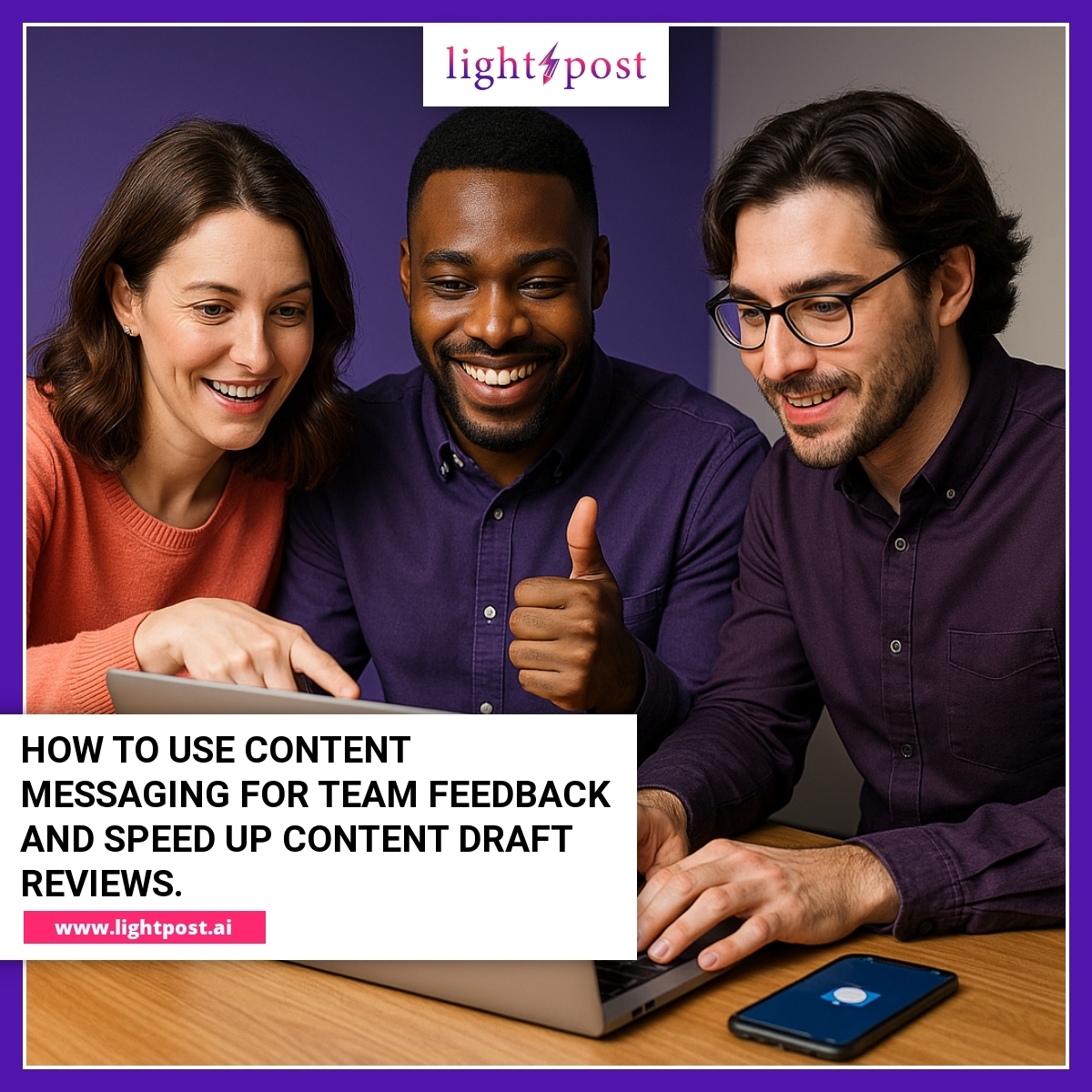The Overlooked Impact of AI-Powered Language Tone: Making Your Lightpost-Generated Posts Feel More “You” and Less Generic
Social media is loud and busy—standing out feels impossible when every post “blurs together.” Here’s a hard truth: if your posts sound generic, nobody remembers them. Tuning your AI-powered content to match your real-life style is not just a “nice to have”—it’s survival for brands that want connection, not just reach. Most businesses know they need more personal, human-feeling posts. But they run out of hours, ideas, and—let’s be honest—patience. This is where Lightpost steps in. Imagine actual, actionable steps for how to make ai social media posts sound like me, not sound like another robot in the feed. You’re about to get them. We’ll dig into why AI tone is your not-so-secret advantage, how to make “your voice” automatic, and what top brands are already doing to nail this in 2025.
What makes AI tone so important when writing posts with our software?
Choosing the right AI tone sets the mood for every post—adjusting this setting is how to make ai social media posts sound like me, not like an algorithm in disguise. AI tone is the fastest way to make your brand voice stand out, skip tedious editing, and start getting more authentic reactions from your audience.
Fine-tuning AI tone impacts trust and engagement at every level. Content with a brand voice, not just “neutral” or “friendly” settings, is more likely to be shared and remembered. Pro content creators use tone adjustments to match campaign goals—if it doesn’t fit your audience, don’t default to basic presets. Even big platforms can’t offer what Lightpost now delivers: a streamlined editor that brings tone control right up front, not hidden in settings. For a deep-dive on building a voice that lasts, see this guide.
Don’t just set it and forget it—tweak your AI’s tone slider for every campaign.
Most users leave the default AI tone as-is, missing the single biggest driver of sharable personality-driven content. Before publishing, professional marketers open Lightpost’s built-in editor, use the preview window, and quickly swipe between tones per topic or season. This is more than a trick—it’s how you go from dull to distinctive. In Lightpost, you can preview and compare, then A/B test with just a couple of clicks. Here’s the play: experiment with a “you-focused” tone on a service update or announcement, then compare engagement with standard text versions. Funnels benefit from this flexibility too; tweak, test, then schedule using this workflow. This attention to tone customization lifts your posts far above the crowd.
Ready to dial up that tone? The next step is layering in your specific brand signals so AI posts truly sound like you—and not a fill-in-the-blank template.
How do you shape an AI-generated post so it actually sounds like your brand—not a robot’s?
Shaping an AI-generated post to actually sound like your brand means giving the system real-world samples and vocabulary. Upload your best posts, old newsletters, or landing page copy; Lightpost’s engine reads and adopts your favorite phrases. Using a steady bank of brand language—from customer nicknames to running jokes—trains the AI to echo your vibe everywhere.
Brands that build a digital vocabulary bank report measurably better recognition among their audience. If you add catchphrases, taglines, and statements of values as part of your brand voice into Lightpost, the AI-powered content becomes unmistakably yours. The more examples you feed, the more naturally your style comes through—Lightpost makes this easy with tailored onboarding and context-aware suggestions. For a roadmap, bookmark the official brand voice guide, or brush up on engagement-building ideas here.
Here’s how to sneak your quirks into even the shortest posts.
- End every sign-off with your preferred closer, like “See you out there,” to reinforce identity—even in tiny posts. Insert this as a template default in Lightpost’s content generator, so every auto-post stays distinct.
- Add context-aware emojis right after your main point if you want warmth; Lightpost recognizes and keeps these for your recurring campaigns.
- Save and re-use “snippets”—whether it’s a two-sentence rant, a brand mantra, or a loyal customer shoutout—and drop them as reusable elements each time you generate new content. For longer campaigns, keep these in your login dashboard; planning ahead with a content calendar makes consistency simple.
So, how much does it really cost to blend in? Failing to personalize just drags your page into the void. The next step is understanding why generic AI never sparks real interaction—and how to fix it instantly.
Why do generic AI posts hurt your engagement—and what’s the fix?
When AI-generated posts sound like everyone else, they merge into the background of a busy feed—users spot and ignore generic AI content almost without thinking. Engagement drops fast if you use basic factory settings. The secret fix: personal touches and voice tweaks always earn more attention. Even at scale, a little brand-specific personality doubles or triples your odds of comments and DMs, according to Lightpost’s field data.
Here’s what the pros do: dig into top-performing posts in your feed and reverse-engineer the AI tone choices that worked for those. Make those settings your new starting point for every campaign. This doesn’t require a data background—just a sharp ear for voice. For a breakdown of why most content creators miss this, check out the content challenges many small business owners face. If you want to get your intros right out of the gate, study these tactics for engaging blog hooks.
The surprisingly high cost of “safe and bland”—and what pros do instead.
- Run a quick A/B test: publish the default AI version, then push out a version with your own language—maybe something you’d actually say in your living room. Track which gets more replies or starts conversations.
- Inject a one-sentence origin story, a quick “odd but true” anecdote, or something a customer mentioned that week. Even a break from typical corporate tone is enough to disrupt “pattern fatigue” in your audience’s scrolling.
- Take two minutes to review scheduled content for “autopilot language.” Replace one headline or subhead per post with your own real-world phrase. If it feels like a human wrote it, you’re doing it right. For more on repurposing your best material in clever ways, see this piece or dive into the Lightpost blog.
It’s easy to forget tone behind all the automation. So, what tools does Lightpost offer to make AI adjustment—fast and repeatable—even easier?
What simple tools does Lightpost offer for dialing in your AI tone fast?
Lightpost’s editor makes switching between tone presets simple: just use the preview panel to cycle through different voices and watch the post rewrite itself in real-time. Tone presets are more than just “cheerful” or “professional”—save your most-used tones and assign them to different post types, so every repeat campaign feels consistent. This saves time, especially during approvals or content checks.
Once you’ve found tones that work, you can save them for future use and even set auto-assign rules by campaign type, cutting down post-production headaches. The “tone memory” makes sure your quirky event updates or serious service announcements sound like the same brand, month after month. Keep your options fresh—update monthly as trends and seasons change. Get the full rundown on collaborative editing, and if you’re balancing creative flair with automation, check this workflow.
Unlock the “hidden” tone features — here’s where to find them in your dashboard.
- Use the custom input field in the Lightpost dashboard to paste a new campaign slogan, event tagline, or value statement—AI will adjust its voice to match instantly, with zero coding.
- For subscription users relying on automation, update your tone bank at onboarding (Lightpost prompts this for new users), then revisit settings after your first campaign to fine-tune results and save yourself costly rewrites later.
- Customize each auto-post template to start with a human note or callout; tie in stories from your weekly team updates, so every scheduled message holds a spark of the real people behind the brand. Direct users to the campaign funnel setup or repurposing strategies here for richer long-term engagement.
Want to know what today’s top brands are doing? Let’s dig into making creativity and inclusivity core to every brand voice in 2025.
How do leading brands keep their AI-powered content creative, inclusive, and human in 2025?
The most successful brands don’t rely on AI output alone—they blend draft posts with human review. After Lightpost AI drafts a campaign batch, a teammate or brand manager will review for tone, warmth, and inclusivity, then tweak for direct address to the audience. This habit consistently halves the “robotic” post rate. Lightpost supports this with built-in collaboration, letting teams tag reviewers and leave tone notes before approval. Creative brands push Even further—embedding real anecdotes, staff quotes, and even customer thanks into AI-generated frameworks.
Teams using these features alongside traditional campaigns maintain a more human online presence. For real-world proof, take a look at how Lightpost’s tech is transforming AI-powered marketing. For experimental formats and writing techniques that spark engagement, scan the guide on innovative strategies.
Steal their playbook: easy ways to make every AI post feel like it’s got a pulse.
- Assign a coworker as your “human filter.” Before content goes live, they read the post out loud. If it doesn’t feel like your brand’s actual voice, they tweak the AI tone before launch.
- Lightpost’s content calendar is where the magic happens; drop micro-stories, funny staff moments, and shoutouts into calendar notes, then have the AI incorporate these in upcoming posts. Over time, this builds a rich, crowd-sourced brand persona.
- Apply this approach each month to new campaigns. “We are what we repeatedly do. Excellence, then, is not an act, but a habit.” (Aristotle 💡) For strategies on steady content improvement, see the optimization guide, and for SEO-specific advice, learn to repurpose assets with a creative, human boost.
A quick reminder: Lightpost isn’t just stacking up new features for show. Recent updates mean our AI now “memorizes” your original posts, analyzes your site language, and fine-tunes every draft for maximum brand authenticity._ Paired with direct social integrations and “no-code” auto-posting support, Lightpost delivers a level of personalization and control that stands far beyond anything generic automators can achieve._ 🌱
Every brand wants to sound more like itself—even when automation is running the show. Lightpost makes that possible. Ready for your brand to feel unmistakably human everywhere you post? Try Lightpost’s AI tools and watch your voice come to life. 😊
[*SOURCES: jamesdavid.co, lightpost.ai, make.com]






